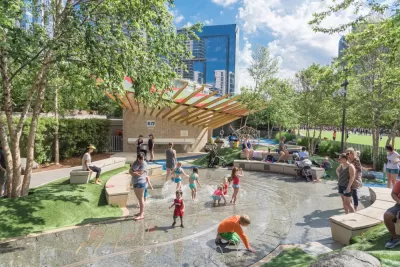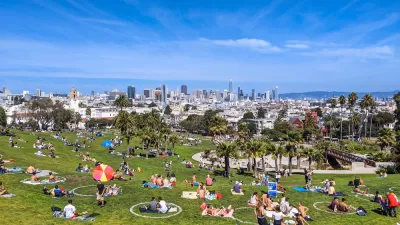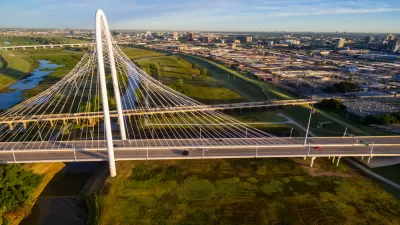The new urban public realm in the United States is highly programmed—some of that design approach reflects the trends of culture and some reflects a history of violence and bad for PR for parks at the end of the 20th century.

John King writes on the current trends in park design…actually, park programming. King's treatise begins with the example of Klyde Warren Park in Dallas.
Klyde Warren Park, constructed over a recessed stretch of the Woodall Rodgers Freeway, is a source of civic pride, a weekend magnet for residents from throughout the region, and a marketing hook used to lure residents to the glass condominium towers nearby. But in a broader sense, it is emblematic of the kind of public space favored by American cities at the moment—meticulously designed and programmed, city owned but privately funded and maintained, with an ever-changing array of carefully curated experiences. At Klyde Warren, you can play pétanque or croquet, laser tag or chess. You can practice your putting or take a ballroom dance class. No need to bring your own Jenga blocks; they can be checked out from the well-stocked Reading and Games Room. Public spaces such as this—picturesque destinations with plenty to offer and little left to chance—are made for the Instagram age. If they enrich public life in an era when the competition for resources is intense, they’re also oddly suited to an American culture in which the unknown is increasingly feared, and being aimless is the biggest sin of all.
Other, relatively recently designed and opened parks are compared for similarities—Millennium Park in Chicago, the High Line in New York City, Public Square in Cleveland, Crescent Park in New Orleans, Salesforce Park in San Francisco, Campus Martius Park in Detroit, Franklin Square in Philadelphia, and LeBauer Park in Greensboro, North Carolina.
Perhaps the most famous park of U.S. history offers a contrast. Frederick Law Olmsted and Calvert Vaux chose a decidedly different approach when designing Central Park in New York City, explains King:
When the pair designed New York’s Central Park, Olmsted sought to “completely shut out the city from our landscapes,” crafting refuges where people “may stroll for an hour, seeing, hearing, and feeling nothing of the bustle and jar of the streets, where they shall, in effect, find the city put far away from them.”
This long-read digs much deeper into the concepts and parks that best exemplify the tension between programmed park space and a more open approach. Regarding the latter approach, King identifies a term from sociology called "Loose Space" and also finds contemporary landscape architects who prefer a less programmed nature in parks.
King also helpfully notes that while the debate surrounding the tension between programming and nature gets attention in academia and from erudite designers, politicians are neglecting to pay much attention to these distinctions.
FULL STORY: At Play in the Fields of the Bored

Planetizen Federal Action Tracker
A weekly monitor of how Trump’s orders and actions are impacting planners and planning in America.

Maui's Vacation Rental Debate Turns Ugly
Verbal attacks, misinformation campaigns and fistfights plague a high-stakes debate to convert thousands of vacation rentals into long-term housing.

Cuomo Is the Candidate of Both NIMBYs and Developers. What Gives?
In the New York City mayoral race, odd bedfellows align to preserve the housing status quo.

Amtrak Rolls Out New Orleans to Alabama “Mardi Gras” Train
The new service will operate morning and evening departures between Mobile and New Orleans.

The Subversive Car-Free Guide to Trump's Great American Road Trip
Car-free ways to access Chicagoland’s best tourist attractions.

San Antonio and Austin are Fusing Into one Massive Megaregion
The region spanning the two central Texas cities is growing fast, posing challenges for local infrastructure and water supplies.
Urban Design for Planners 1: Software Tools
This six-course series explores essential urban design concepts using open source software and equips planners with the tools they need to participate fully in the urban design process.
Planning for Universal Design
Learn the tools for implementing Universal Design in planning regulations.
Heyer Gruel & Associates PA
JM Goldson LLC
Custer County Colorado
City of Camden Redevelopment Agency
City of Astoria
Transportation Research & Education Center (TREC) at Portland State University
Jefferson Parish Government
Camden Redevelopment Agency
City of Claremont





























